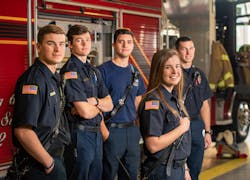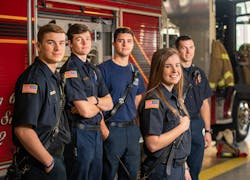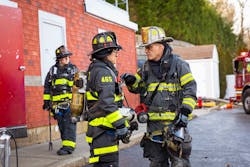Staffing the Volunteer Fire Department
This article is part of a larger supplement titled Recruiting and Retaining: The Future of Volunteer Fire Departments. View the supplement in its entirety here.
The volunteer fire department model has changed. If, as a leader in the volunteer fire service, you haven’t made changes in how you maintain and grow your fire department, then you have fallen behind. We know the importance of maintaining membership to execute the mission of the volunteer fire department and to adequately protect and serve our communities. Recruitment and retention of volunteer firefighters has become a major focus for most departments as they see their ranks dwindle and find it more and more difficult to fill their rosters.
The three “R”s
Although a lot of people use “retention” and “recruitment” in conjunction with one another in discussions about staffing needs, these terms are, in fact, separate and unique areas that must be addressed to find success in building and maintaining emergency response. It also is critical to understand that there’s a third “R” in this process, and it’s just as important as the other two: “replacement” as in the replacement of an aging workforce of volunteer firefighters and leadership.
Statistically, the research is clear: The American volunteer fire service is aging out. According to data from the National Fire Protection Association (NFPA), one-third of firefighters who are in communities that have a population of fewer than 2,500 are at least age 50, and another 21 percent are in their 40s. This means that in the next 10–20 years, we risk losing half of the volunteer workforce that’s in these communities as they retire from the service. The ages of firefighters in communities that have a population that’s between 2,500–24,999 also increased considerably compared with a few decades ago. Couple that with the significant loss of younger members who join the volunteer fire service, and we have a crucial problem for volunteer fire departments and their communities.
Market recruitment
Where are the answers? The fact is that traditional methods of recruiting new volunteers aren’t working, at least not to the extent that they used to. Therefore, let us look to the future—a future that’s filled with some of the brightest, multitasking, curious go-getters that the fire service ever has seen. Let us change our model of recruiting new members to keep up with the next generation instead of grounding ourselves in a past that no longer exists.
Ever since I can recall—and I am into my 45th year of the fire service—fire service leaders weren’t required to market their fire department. Volunteers sought us out, often due to family involvement with the department, and, generally, it took very little effort to fill rosters. The reality now is quite different. Generational firefighting families are getting fewer, and we need to start engaging a new generation that might have no connection to the fire service.
Today, it’s essential to not only sell your pride and the worthiness of your fire department but sell to the community that you’re a volunteer fire service and that you seek quality candidates to join your ranks. These things no longer are common knowledge in the community, which makes marketing the key to success. You must learn to tap into the social media outlets and to capitalize on new ways to sell your department to prospective candidates. If you don’t have the skill set to use social media and other new forms of marketing to promote your department, then you must enlist someone who does. We need to move into the modern age if we’re going to attract the next generation of volunteer firefighters.
Foster retention
Separating recruitment from retention is key. Today in the volunteer fire service there is a focus on recruitment. We spend all of our efforts trying to draw new candidates to join us. Although it’s true that we need to attract new members—particularly that “next” generation—I contend that it is just as important (perhaps even more critical) to focus on the retention of our current members.
With successful retention of your volunteer fire force, recruitment becomes less of an issue. You no longer are caught in the revolving-door cycle of needing to constantly find new volunteers to fill the vacant spots left by capable, trained members who leave because they’re unhappy with their volunteer experience. Good retention strategies also mean that, when you do recruit new members, they’re more likely to serve a longer, more productive tenure with your department. In addition, volunteers who are satisfied with their experience create a more positive perception of the department within the community, which makes it more enticing for people to join and stay with the organization.
How do you foster volunteer retention? First and foremost, it’s imperative for fire service leaders to maintain a commitment to your volunteers. Keep your finger on the pulse of your members. Always keep the lines of communication open, and if there is a problem, work to find a solution. Reach out to any members who you see are fading away; a simple phone call, text or email sends a message that you care.
Obviously, all of our fire departments lose members for various reasons. Some of these are beyond our control, such as the person who moves to a career position within the fire service or leaves the area because of a change in employment. Others leave for reasons that are within our power to change. It’s important that you gather the data as to why your volunteers leave. Conducting exit interviews with all volunteers who leave will help you to understand why your members move on and to identify problem areas that you can fix to avoid losing more members in the future.
Fire department leaders also must be inclusive and aware of the differences that individuals bring to the department. Our next generation of volunteer firefighters think differently, learn differently and act differently than their predecessors. These are quality characteristics, for they are multitaskers, efficient and flexible. They don’t want to waste their valuable time, but they do want to train and learn. They want to be mentored and to absorb knowledge from the more veteran firefighters. These younger members have a great sense of social responsibility, and they want to make a difference. They also want to gain responsibility and to be involved. These are up-and-coming leaders within the fire department, and succession planning is the key—which brings us to the third R.
Focus on replacement
Looking toward the future of your fire department, you must assess the leadership characteristics of those who will replace you and nurture their progression in the department. In the past, many departments chose their officers based on popular vote rather than leadership skills and experience. Electing officers without having established job responsibilities and criteria is a very narrow approach to building a viable future for the volunteer fire department. It’s in the best interest of the department to establish officer criteria, expectations, job descriptions and minimum requirements for leadership positions. This is a critical change and a vital adjustment. Once you have these pieces in place, succession planning can be proactive and deliberate. Members will have a clear understanding of what’s needed to attain these positions and can follow the necessary path to becoming a leader.
Changing your process for leadership replacement will allow your fire department to grow. Begin with identifying emerging leaders within your fire department. Identify your positions that need transition, and set a time frame to move forward. Work with those emerging leaders, and provide training and leadership development. Garner the support of all of your members as you move to transition into a different fire department—a fire department that sustains the mission of the organization. Although it might be difficult to let go of the old ways in favor of a new, measured succession strategy, the outcome will be well worth the commitment. Knowing that your department will be able to continue protecting your community long after the current set of leaders is gone is fulfilling. Your willingness to pave the way for the future of your department is noble.
Yes, the volunteer fire service model has changed, and we need to adjust our process to be successful and to maintain protection of our communities. It all comes down to the three Rs—recruitment of the next generation, retention of our workforce and replacement of our leadership through thoughtful succession planning.
With this as our focus and with a willingness to change, we will see our departments grow and our missions fulfilled to protect our communities. We have a duty to act, a duty to respond and a duty to change!
About the Author
Kevin D. Quinn joined the fire service in 1976. He is the Rhode Island director on the National Volunteer Fire Council (NVFC) and is past chair and currently first vice chair of the council. He retired as a deputy chief of the Union Fire District in South Kingstown, RI, and returned to where he began in the volunteer fire service— actively responding to fires and alarms with his original Station #3 of the Union Fire District.
About the Author
Kevin D. Quinn
Kevin D. Quinn joined the fire service in 1976. He is the Rhode Island director on the National Volunteer Fire Council (NVFC) and is past chair and currently first vice chair of the Council. He retired as a deputy chief of the Union Fire District in South Kingstown, RI, and returned to where he began in the volunteer fire service—actively responding to fires and alarms with his original Station #3 of the Union Fire District.


